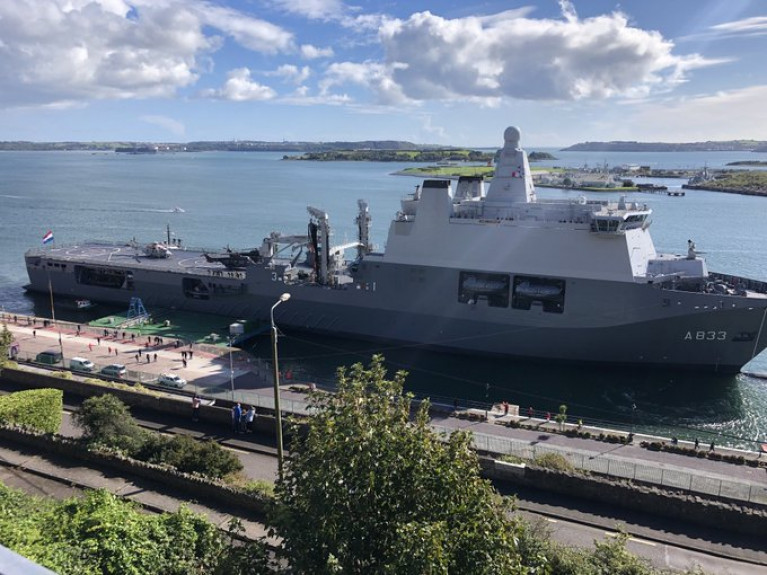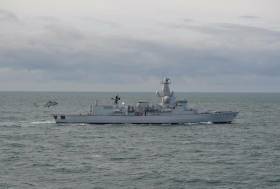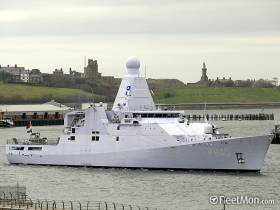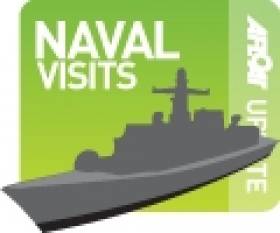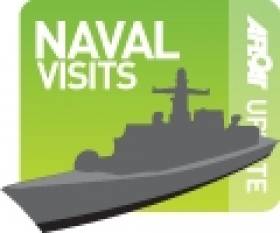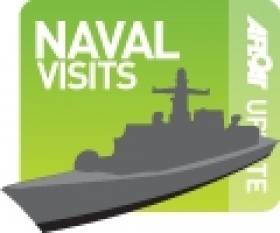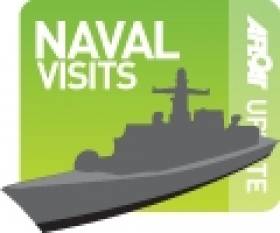Displaying items by tag: Dutch Navy
First Foreign Naval Ships Since Pandemic Begun Call to Irish Ports
Foreign naval ships have called to Irish Ports for the first time since the pandemic begun, writes Jehan Ashmore.
The Royal Netherlands Navy's largest ship HNMLS Karel Doorman, displacing 27,800 tonnes, arrived in Cork Harbour this afternoon to berth at Cobh, having sailed from Greenock, Scotland.
HNLMS Karel Doorman is a joint logistic support ship designed and built by Damen Schelde Naval Shipbuilding (DSNS) and was officially named and commissioned in March 2014. The 204m vessel can carry helicopters and can be used for multiple naval support missions.
Whereas the shorter 166m HNLMS Rotterdam arrived in Dublin Port yesterday afternoon and berthed at the North Wall Extension next to the Tom Clarke (East-Link) toll-bridge.
The leadship 'Rotterdam' class vessel is a Landing Platform Dock (LPD) amphibious warfare ship of 12,750 tonnes and was also built by DSNS and commissioned into service in 1998.
Prior to the arrival of HNLMS Rotterdam, Afloat observed in Dublin Bay the ship's landing craft in the vicinity of the vessel while offshore of Dun Laoghaire Harbour.
The landing craft are accommodated in the ship's aft dock and above the hull in the superstructure is equipped a large helicopter deck for related operations.
Trio of European Neighbouring Nation's Navies to Visit Dublin Port Over May Bank Holiday
#NavalVisits - Navies from neighbouring nations of France, Belgium and the Netherlands are to arrive in Dublin Port today in advance of the May Bank Holiday Weekend, with one ship from each navy visiting, writes Jehan Ashmore.
First to arrive is the French Navy's Éridan class minehunter Andromède (M 643) one of the 'Tripartite' vessels completed in collaboration of the three visiting navies to the Irish capital.
Already in the port to welcome the trio of European naval visitors is the Naval Service's OPV90 class L.E. William Butler Yeats (see story). The second of three 'Beckett' class sisters in service, arrived on Tueday and is berthed at Sir John Rogerson's Quay.
While across Dublin Bay, is where yesterday CPV L.E. Ciara docked in Dun Loaghaire Harbour where an unusual caller the ro-ro Stena Carrier underwent a survey. Some of the '4Runner' class sisters down the years have been chartered to the UK's Royal Fleet Auxiliary and NATO.
Returning to Dublin Port is where Andromède is to berth at Sir John Rogersons Quay closer to the centre of the capital. It was in the French capital yesterday where Minister for Agriculture Food & Marine, Michael Creed TD met his French counterpart, Stephane Travert.
Afloat adds during the French naval visit, the Association of Veterans of the Foreign Legion in Ireland meets for the annual commemoration of the Battle of Camarón. The ceremony this year will take place on the Bank Holiday Monday, 5 May at 11:45 am at Collins Barracks. This free event is open to all to attend at the venue close to the banks of the Liffey.
As for this morning, the Dutch Navy's HNMLS Evertsen (F805) is to make an appearance albeit docking at a deeper quay downriver. The vessel is the fourth De Zeven Provinciën-class frigate of the Royal Netherlands Navy.
The third visitor, the Belgian Navy's BNS Louise-Marine (F931) will arrive in the afternoon and is to berth next to Andromède. The final caller to the capital is the second of a pair of Karel Doorman-class frigates of the Belgian Maritime Component (the official name of the navy). The frigate commissioned in 2008 was acquired three years previously from the Netherlands Navy.
#NavalVisits – One of the biggest Royal Netherlands Navy ships and a frigate is to visit Dublin Port, so to enable crew members time-off in addition to carrying out diplomatic and trade functions, writes Jehan Ashmore.
The Rotterdam-class HNLMS Johan de Witt, a Landing Platform Dock (LPD) amphibious warfare ship is of 16,500 displacement tonnes. The LPD ship is the second largest unit of the fleet and is named after a key figure in Dutch politics during the mid-17th century. This was a time when Dutch sea trade was notably flourishing and expanding on a world-wide stage that made the United Provinces a leading European power during the Dutch Golden Age.
As for the second naval visitor to the Irish capital, this will be a De Zeven Provinciën-class frigate HNLMS Evertson. The pair are to arrive tomorrow and remain in port over the weekend.
Afloat contacted the Dutch Embassy as to the purpose of the visit which said it would provide rest and recreation time for crew members. In addition to hosting on board receptions for members of the Diplomatic Corps as well as local Dutch businesses. The embassy added that unfortunately due to insufficient time, neither naval vessels will be open to the public.
The 166m HNLMS Johan de Witt can transport army troops along with associated vehicles and dispatch landing craft from the stern located landing well-dock. Above decks, helicopters can also be deployed from a hanger and use of two landing spots. In addition the LPD is equipped with a hospital featuring an operation theatre and intensive care facilities.
A sister of HNLMS Johan de Witt, the leadship of the namesake class HNLMS Rotterdam, have together previously paid a visit to Dublin. The leadship built by Damen Schelde Naval Shipyards was commissioned in 1998, whereas HNLMS Johann de Wit was constructed overseas in 2007 on the banks of the Danube in Galati, Romania. Another notable difference is that the leadship weighs in at a smaller 12,750 displacement tonnes.
Accompanying the LPD will be a De Zeven Provinciën-class frigate HNLMS Evertson of 6,050 displacement tonnes which was also completed by the same Dutch yard group. The 144m frigate has among armaments Goalkeeper guns and Sea Sparrow missiles. A helicopter can also be carried with flight crew joining a crew compliment of 174.
It is almost a year ago since a pair of these frigate class sisters paid a call to the capital following a major UK led naval exercise ‘Joint Warrior’ that involved other European navies.
As for the Dutch Navy, all of their ships have the prefix HNLMS (His Netherlands Majesty’s Ship) which are under the command of Commodore Ludger Brummelaar. On 1st January this year, he was appointed as the new Chief of the Military Household of His Majesty the King.
The Commodore is the first to be promoted to the rank of rear admiral and has succeeded Major General Hans van der Louw.
Dutch Visit Ireland On Trade Call to Cork City
#HollandVisit- A Royal Netherlands Navy ship is to visit Cork City for crew rest and recreation in addition to promoting Dutch trade and business interests in the Munster region, writes Jehan Ashmore.
HNLMS Holland the leadship of its namesake class of around 3,750 tons full displacement is to enter Cork Harbour today. The Offshore Patrol Vessel is to berth at North Custom House Quay in the Cork City and remain until Tuesday.
Among the Dutch firms attending the trade events, is the engineering company Royal HaskoningDHV which has been appointed by Irish Water to the Dublin Ringsend Wastewater Treatment Plant project team. Royal Haskoning are to provide expertise on its sustainable wastewater reduction treatment technology.
As for the HNLMS Holland, she shares the same shipbuilder of the ILV Granuaile, the Commissioner of Irish Lights aids to navigation tender that was launched at Damen Shipyards Galați in Romania. Both vessels were also fitted-out at the Dutch group’s facilities back in the Netherlands.
The Holland class are designed to fulfill patrol and intervention tasks against lightly armed opponents, such as pirates and smugglers, noting the Dutch overseas territories in the Caribbean.
At the same time they are equipped to cope with much higher level electronic and radar surveillance capabilities used for military stabilization and security roles, short of outright war.
A surveillance system, Thales is integrated into the mast which integrates communication systems and where there are two 4-faced phased arrays for air and surface search.
At the stern are aviation facilities of a fully equipped hangar and flight deck for one medium-sized helicopter.
Dutch Navy Replenishment Tanker Visitor Sold to Peruvian Navy
#DutchNavy – According to Ships Monthly, the Royal Netherlands Navy combat support ship HNLMS Amsterdam which visited Dublin Port in April, as previously reported (with photo) has been sold to the Peruvian Navy.
An economic upturn in Peru has enabled the acquisition of the 17,000 tonne auxiliary replenishment vessel (AOR), which can supply 8,475 tonnes of fuel and 290 tonnes of stores.
She is equipped with 30mm Goalkeeper CIWS systems and a large stern flight-deck and hanger capable of operating up to three medium-sized helicopters.
The 19 year old vessel is scheduled to be transferred to her new South American owners in December. Her sale leaves the Dutch Navy without a tanker until her replacement, Karel Doormen, the new Joint Logistic Support Ship due for delivery in 2015.
Largest New Dutch Navyship to Replace Recent Dublin Port Visitor
#DutchNavyLargest – Following last weekend's visit to Dublin Port of Royal Netherlands Navy (LPD) landing platform dock ship HNLMS Johan de Witt and (AOR) auxiliary replenishment tanker HNLMS Amsterdam, the latter is to be replaced by the Dutch Navy's largest vessel, a newbuild in 2015, writes Jehan Ashmore.
HNLMS Amsterdam and HNLMS Zuiderkruis, also an oil-fuels replenishment carrier, will be disposed by a the largest unit in the Dutch Navy, the €360m newbuild Karel Doormen at 28,246 tonnes and almost 207m in length. The Joint Logistics Support Ship (JSS) was constructed by the Damen Group's shipyard in Galati, Romania, the same yard that built Commissioners of Irish Lights ILV Granuaile.
The Karel Doormen was towed to her homeland and fitted-out at Vlissingen from where the newbuild was last month named by the Dutch Defence Minister Jeanine Hennis-Plasschaert. She is to undergo sea-trial next month and commissioned into service in 2015 and then officially named "HNLMS Karel Doormen". She will be a major asset for the Dutch Navy, NATO and the EU forces.
The JSS primary role asides replenishment at sea serving two vessels simultaneously and equally on that note the capacity to handle a pair of Chinnook helicopters on a flight deck plus a hanger for six more helicopters. In addition her JSS remit is to provide logistical support, strategy sealift and duties supporting of land-based forces.
Among the roles of the JSS, this is achieved by the provision of up to 2,000 lane metres for military vehicles and container-stores equipment accessed by a rear-quarter ramp.
Likewise to HNLMS Johan de Witt a landing platform dock (LPD) ship, the newbuild will transport troops and handle two landing craft, considerably less compared to up to 8 accommodated as of the older pair of LPD half-sisters, the other been leadship HNMLS Rotterdam.
Together these LPD vessels paid a visit to Dublin Port in 2007, which was notable and berthed within Alexandra Basin East and Ocean Pier, however more unusually for a foreign navy was to visit an Irish port during winter. On that occasion the call took place in November.
Dutch Navy Stealth Frigate to Visit Cork City Centre
#NAVY VISITS -HNLMS Evertsen (F805) a Dutch naval frigate with a crew complement of 200 is due to make a weekend courtesy call to Cork City, berthing at J.J. Horgan's Wharf, writes Jehan Ashmore.
She is a sister of HNLMS De Ruyter (F804) which docked in Dublin Port last month, as previously reported in this section. The 144m frigates form two of a total of four De Zeven Provinciën-class air-defence and command frigates (LCF). The class present sharp angular lines (see PHOTO) due to stealth design technology to minimise radar signature detection.
Armament consists of a bow-mounted Oto Breda 127 mm cannon, vertical launch systems for various missile types, a 'goalkeeper' rapid-fire gun, an Oerlikon 20mm machine gun and a Mk. 46 Torpedo weapon system. At the stern she can carry a Lynx or NH-90 helicopter.
They displace 6,050 tonnes and propulsion plant are 2 x Wärtsilä 16 V26 diesel motor engines (13,600 hp total), 2 x Rolls Royce Spey SM 1A gas turbines (52,300 hp total). The class can achieve 30 knots and entered service between, 2001-2005 from the Royal Schelde Group shipyard in Flushing.
Dutch Naval Stealth Frigate On Visit to Dublin Port
The class have two roles, to command operations and deployment of the Royal Netherlands Navy, the Netherlands Maritime Force (NLMARFOR). In addition they are equipped for air-defence tasks and must be capable of providing protection for an entire fleet.
This dual-role task is the reason that the ships are known as air-defence and command frigates (LCF). The frigates all entered service between 2001-2005 and were built by the Royal Schelde Group, of Flushing, Netherlands. The design also involved participated from Spain and Germany.
Stealth Frigates to Visit Dublin Port
Two Dutch naval frigates, HNLMS Tromp and HNLMS Van Amstel are due to arrive into Dublin Port tomorrow for a courtesy visit over the weekend, writes Jehan Ashmore.
The Royal Netherlands Navy HNLMS Van Tromp is a De Zeven Provinciën-class air-defence and command frigate (LCF). The class has a striking streamlined visual appearance, through the use of stealth design technology. The stealth design is to minimise the vessels signature as much as possible from the detection of enemy vessels using radar.
At 6,050 tonnes, the stealth frigate is one of five built by the Royal Schelde Group, of Flushing, Netherlands. Spain and Germany also participated during the design stage of the 144-metre class which are powered by gas turbine engines capable of reaching 30 knots.
They are equipped with an Oto Breda 127 mm cannon, vertical launch system (VLS) Mk 41 for Evolved Sea Sparrow Missile (ESSM), Standard Missile and Harpoon Missiles. In addition the frigate has a Goalkeeper (rapid-fire gun), a Oerlikon 20 mm machine gun and a Mk. 46 Torpedo weapon system. The vessel also has the ability to carry a Lynx or NH-90 helicopter.
The second frigate to visit the capital is HNLMS Van Amstel, one of two multi-purpose M-class frigates. The frigate which is also known as the Karel Doorman class can be used for surface warfare and anti-submarine warfare. They also have their own air-defence capabilities.
The 122-metre vessels displace 3,300 tonnes and have a two Rolls Royce (Spey 1A) gas turbines delivering 29 knots. The class are equipped with an array of defence / attack armament to includes an Oto Melara 76 mm gun for surface and air targets, a Harpoon weapon system and a NATO Sea Sparrow Vertical Launch weapon system for use against air targets at close range. Like the De Zeven –class the M-class frigate is also capable of carrying a Lynx helicopter.


























